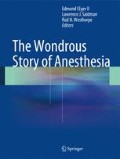Summary
Surgeons in ancient times undertook diverse operations, usually at great speed to diminish the duration of suffering. Skulls from 5,000 BCE show trephination, the removal of a piece of bone from the head. Egyptians in 3,600 BCE performed circumcisions and tracheotomies. In 1700 BCE, Babylonians excised tumors. Egyptians cauterized breast tumors and excised peripheral aneurysms. The Roman surgeon, Galen, in the second Century CE, treated cataracts to restore sight, and he cut out the uvula to cure chronic coughing. Surgeons in Europe might be physicians, monks or barbers who in the thirteenth and fourteenth centuries wrote books on surgery. They gained recognition by their study of the anatomy of cadavers. Thus, in 1543 Vesalius published “On the Fabric of the Human Body”, demolishing centuries of errors, and opening the door to the performance of accurate surgery.
Access this chapter
Tax calculation will be finalised at checkout
Purchases are for personal use only
Notes
- 1.
In the second century CE, Galen treated cataracts to restore sight and cut out the uvula to cure the chronic cough.
- 2.
Ironically, Hunter had angina pectoris, presciently noting that “my life is in the hands of any rascal who chooses to annoy and tease me.” A fatal heart attack at age 65 followed an argument at St. Georges Hospital on 14 October 1793. Pott described the anatomy of congenital inguinal hernias in his “Treatise on Ruptures.” He advocated emergent operations for incarcerated hernias. Most famous was his 1775 Chirurgical Observations, a 5-page essay correctly connecting scrotal cancer in chimney sweeps to their exposure to tars.
References
Plowman T, Rivier L. Cocaine and cinnamoylcocaine content of thirty-one species of Erythroxylum (Erythroxylaceae). Ann Botony (Lond) 1983;51:641–59.
Draelos ZD The ability of onion extract gel to improve the cosmetic appearance of postsurgical scars. J Cosmet Dermatol. 2008;7:101–4.
Juvin P, Desmonts JM. The ancestors of inhalational anesthesia: the Soporific Sponges (XIth–XVIIth centuries): how a universally recommended medical technique was abruptly discarded. Anesthesiology. 2000;93:265–9.
Nuland SB. The origins of anesthesia. Birmington: Adams, Jr.; 1983. p. 11.
Eger EI II, Zhang Y, Laster MJ, Flood P, Kendig JJ, Sonner JM. Acetylcholine receptors do not mediate the immobilization produced by inhaled anesthetics. Anesth Analg. 2002;94:1500–4.
Rutkow IM. The origins of modern surgery, surgery-basic science and clinical evidence. New York: Springer; 2001. pp. 2–19.
Haeger K The Illustrated 2 of surgery. Houston: Bell Publishing Co.; 1988.
Keys TE. The history of surgical anesthesia. Park Ridge: Wood Library-Museum of Anesthesiology; 1996. p. 9.
Ball C, Westhorpe R. Ether before anaesthesia. Anaesth Intensive Care. 1996;24:3.
Gallucci JM. Who deserves the credit for discovering ether’s use as a surgical anesthetic? J Hist Dent. 2008;56:38–43.
Snow J. On chloroform and other anaesthetics: their action and administration. London: John Churchill; 1858. pp. 1–443.
Roberts MF, Wink M. Alkaloids. Biochemistry, ecology, and medicinal applications. New York: Plenum Press; 1998. p 34.
Beach GO, Fitzgerald RP, Holmes R, Phibbs B, Stuckenhoff H. Scopolamine poisoning. N Engl J Med. 1964;270:1354–55.
Brichcin S, Filipova A. Atropine coma therapy and a proposal for using scopolamine in psychiatric treatment. Act Nerv Super (Praha). 1965;7:248.
Brichcin S, Filipova A. [2 years of experience with cholinergolytic comas]. Cesk Psychiatr. 1967;63:248–51.
Major DJ. Chirurgia infusoria placidis CL: vivorium dubiis impugnata, cun modesta ad Eadem, Responsione. Kiloni, 1667.
Dagnino J. Wren, Boyle, and the origins of intravenous injections and the Royal Society of London. Anesthesiology. 2009;111:923–4. (author reply 924).
de la Condamine M. Relation abrégée d’un Voyage fait dans l’intérieur de l’Amérique de, dpuis l Côte de la Mer du Sud, jusques aux Côtes du Brésil et de la Guiane, en descendant la rivière des Amazones. Histoire de l’académie Royale des Sciences 1745:391–492.
Bancroft E. An essay on the natural history of Guiana and South America. London: T Becket & PA De Hont. 1769.
Brodie BC. Experiments and observations on the different modes in which death is produced by certain vegetable poisons. Philos Trans Roy Soc Lond. 1811;102:178–208.
Brodie BC. Further experiments and observations on the action of poisons on the animal system. Philos Trans Roy Soc Lond. 1812;102:205–27.
Sykes K. Harold Griffith memorial lecture. The Griffith legacy. Can J Anaesth. 1993;40:365–74.
Acknowledgment
The authors appreciate the editorial suggestions made by Ms. Shawnee Shahroody Spitler.
Author information
Authors and Affiliations
Corresponding author
Editor information
Editors and Affiliations
Rights and permissions
Copyright information
© 2014 Edmond I Eger, MD
About this chapter
Cite this chapter
Eger, E., Saidman, L., Westhorpe, R. (2014). History to 1798. In: Eger II, E., Saidman, L., Westhorpe, R. (eds) The Wondrous Story of Anesthesia. Springer, New York, NY. https://doi.org/10.1007/978-1-4614-8441-7_1
Download citation
DOI: https://doi.org/10.1007/978-1-4614-8441-7_1
Publisher Name: Springer, New York, NY
Print ISBN: 978-1-4614-8440-0
Online ISBN: 978-1-4614-8441-7
eBook Packages: MedicineMedicine (R0)

